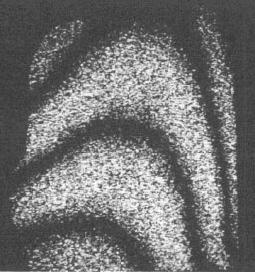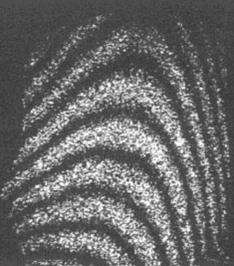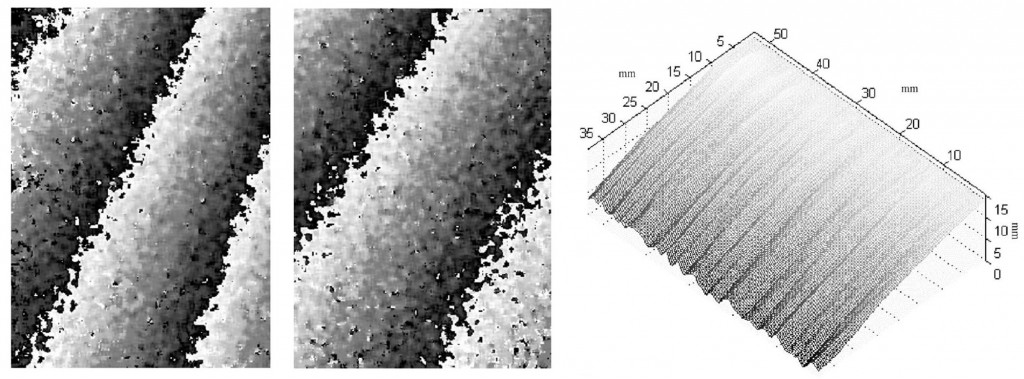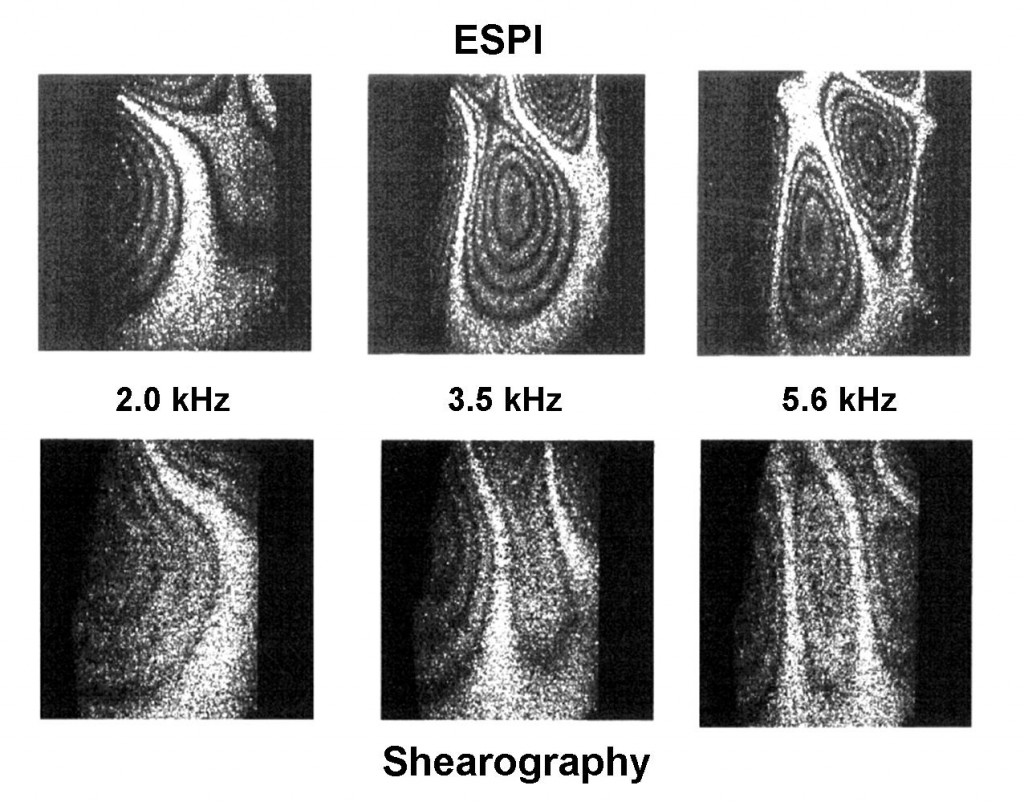Measurement of shape and vibration using speckle interferometry
Shape measurement with ESPI
One method of measuring shape using ESPI that has been investigated in the EPG is the dual-wavelength technique. This technique involves correlating speckle patterns recorded at two different wavelengths. The result is a fringe pattern where the fringes represent contours of surface height. One method of generating the different optical wavelengths is to modulate the operating temperature or drive current of a laser diode. Figure 1 shows contour fringe patterns generated using dual-wavelength ESPI on a gas turbine blade. These images were obtained with frequency differences of (a) 32.6 GHz and (b) 42.9 GHz between the two recorded speckle patterns, which correspond to contour spacings of 4.7 mm and 3.5 mm.
(a) (b)
Figure 1 ESPI contour fringes obtained from a gas turbine blade with a frequency separation of (a) 32.6 GHz and (b) 42.9 GHz between frames.
Slope measurement with shearography
Shearography can be used to measure the slope of an object, where slope is the derivative of the surface shape. One method of measuring slope using shearography involves translating the illuminating source in a direction perpendicular to the optical axis in the interval between recording frames. Figure 2 shows some results obtained using this technique on (a) a cylindrical object of 90 mm radius and (b) a flat plate test object. The experimentally determined shape of the cylindrical object is shown in (c) after a correction had been applied based on the flat plate measurement shown in (b).
Figure 2 Slope fringes obtained using shearography from (a) a cylindrical test object and (b) a flat plate test object; (c) the experimentally determined shape of the cylindrical object.
Vibrational analysis using ESPI and shearography
ESPI and shearography have been used in the investigation of vibrating surfaces. Provided that the vibrational frequency is harmonic and significantly greater than the frame rate of the camera, time averaged fringes can be generated through the subtraction of frames with a π phase shift between them. With ESPI the fringes represent regions experiencing equal displacement due to the vibration, whereas with shearography it is the derivative of the vibrational displacement that is represented. Figure 3 shows ESPI and shearography fringe patterns obtained from a gas turbine blade vibrating at frequencies of 2.0 kHz, 3.5 kHz and 5.6 kHz. Note the bright nodal fringe within each of the fringe patterns, which is due to the fact that the intensity distribution follows a zero order Bessel function. Vibrational analysis with pulsed illumination results in cosinusoidal fringe patterns in which the fringes are of uniform intensity and separation.
Figure 3 Fringe patterns obtained using ESPI (top row) and shearography (bottom row) from a gas turbine blade vibrating at frequencies of 2.0 kHz, 3.5 kHz and 5.6 kHz.
Next: Multi-component shearography
Selected Publications
A mechanically stable laser diode speckle interferometer for surface contouring and displacement measurement
D Francis, D Masiyano, J Hodgkinson, and R P Tatam
Measurement Science and Technology, 26(5), 055402 (2015).
Optical Fibre Technique for Measurement of Small Frequency Separations: Application to Surface Profile Measurement using Electronic Speckle Pattern Interferometry
H D Ford, H Atcha, and R P Tatam
Measurement Science and Technology, No. 5, pp 601-607, 1993. (Reprinted in Engineering Optics, 6 , pp 301-308, 1993).
Holographic Surface Contouring using Wavelength Modulation of Laser Diodes
R P Tatam, J C Davies, C H Buckberry, and J D C Jones
Optics and Laser Technology, 22 , pp 317-321, 1990.
Slope Measurement by Two-wavelength Electronic Shearography
J-R Huang, H D Ford, and R P Tatam
Optics and Lasers in Engineering, 27, pp 321-333, 1997.
Shape and Slope measurement by source displacement in shearography
R Groves, S W James, and R P Tatam
Optics and Lasers in Engineering, 41 , pp621-634 2004 Special Issue: FASIG
Heterodyning of Fibre Optic Electronic Speckle Pattern Interferometers using Laser Diode Wavelength Modulation
H Atcha and R P Tatam
Measurement Science and Technology, 5 , pp 704-709, 1994, (Special Issue: Optical Techniques in Measurement)
Heterodyning of speckle shearing interferometers using laser diode wavelength modulation
J-R Huang, H D Ford, and R P Tatam
Measurement Science and Technology, 7 , 1721-1727, 1996




